Mybatis-plus的自动填充功能
1.数据库级别
一般数据库中的某些字段,例如创建时间(create_time)以及修改时间(update_time)都是自动化完成的,我们不希望手动更新。
所有的数据库表都必须包含两个字段gmt_create和gmt_modified,因为我们需要追踪这个数据什么创建,什么时候被修改的,而且需要自动化!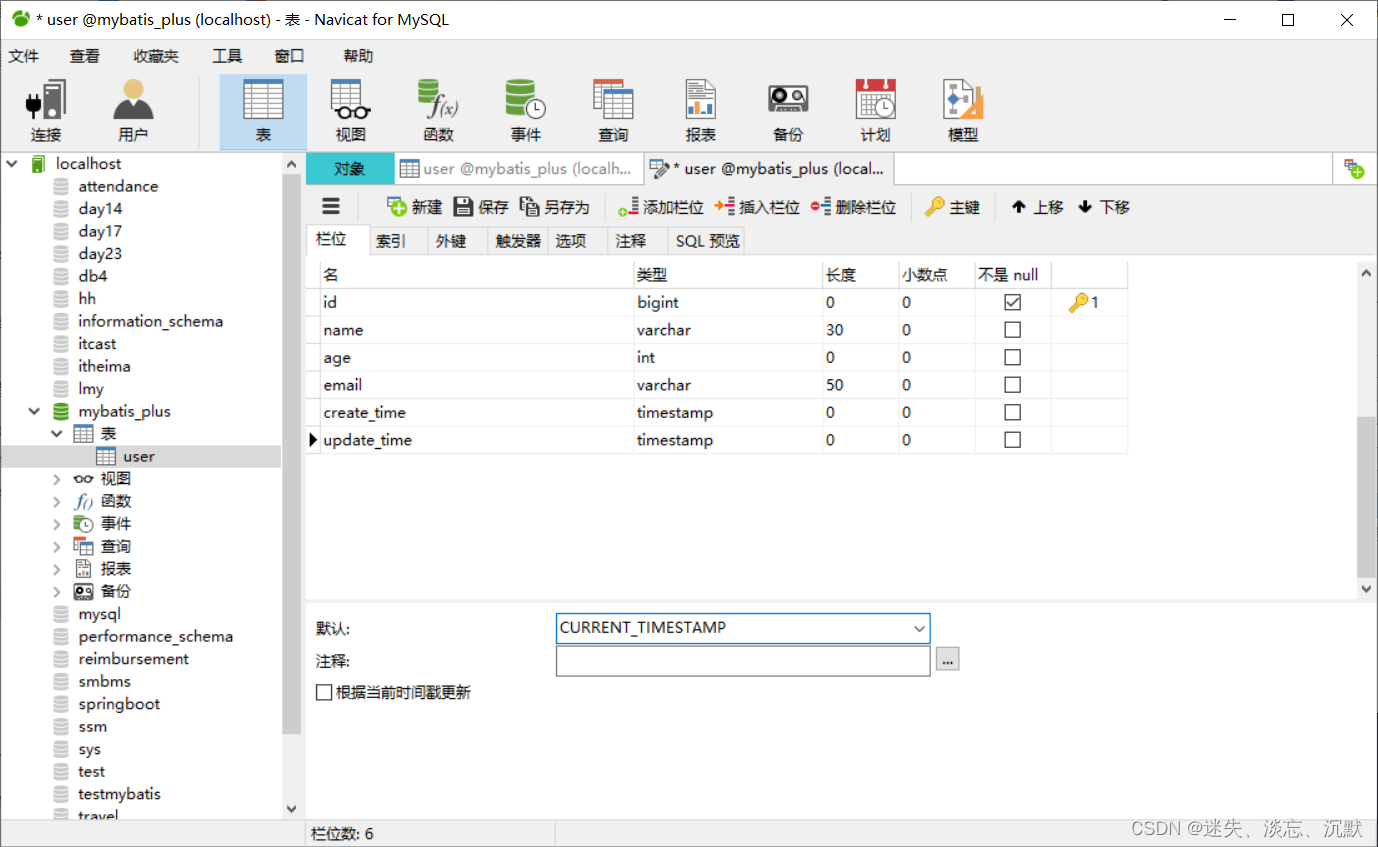
1.修改数据库的表结构
在已有的数据库表(user)中添加create_time和update_time字段,不仅如此,我们需要设置数据类型为datetime,以及默认值为CURRENT_TIMESTAMP,另外还需要在更新时间(update_time)的左下角有一个根据当前时间更新这个也要√,上图忘了加。
第一种数据库级别我们在工作中一般不会让我们修改数据库的,我们不过要知道这种方式。
2.在实体类中添加创建时间(create_time)以及修改时间(update_time)
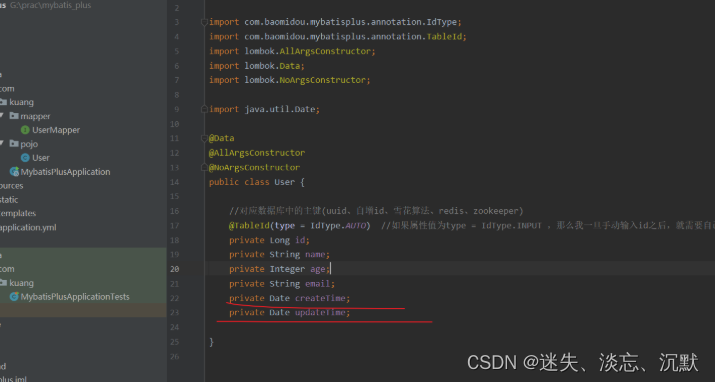
接着我们去实体类User中加入我们的两个字段,这里虽然我们在属性中是使用驼峰命名的,但是我们在数据库刷新的时候会帮我们自动转成下划线的名称方式。因为我们这里在数据库中不区分大小写,所以在数据库里面不能用驼峰。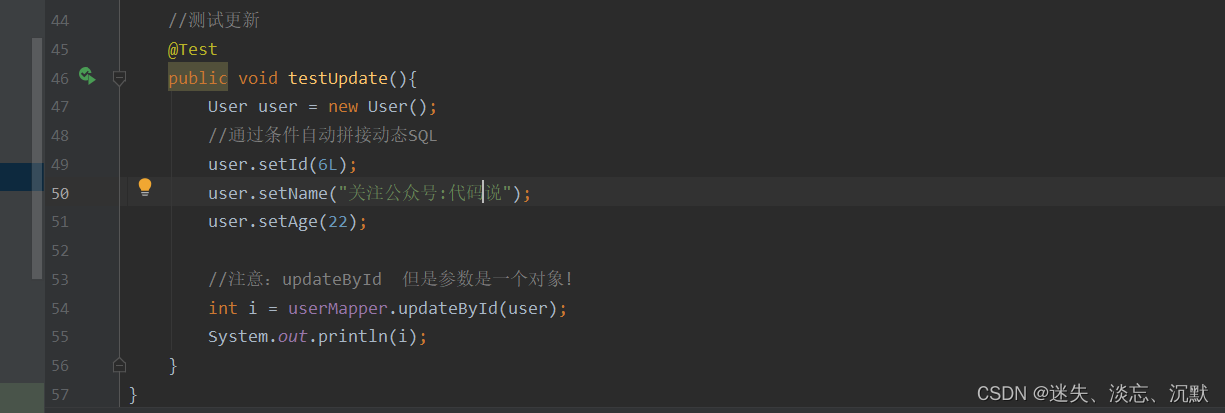
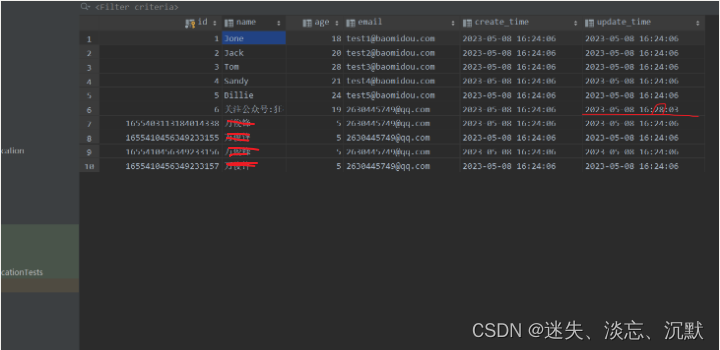
接着我们就去测试类里面改了一个数字,这样我们在运行的时候发现,我们的数据库的时间改变了。
2.代码级别
由于在公司里面数据库一旦创建时不予许修改的,所以我们就需要了解并掌握代码级别的自动填充;
1.修改数据库
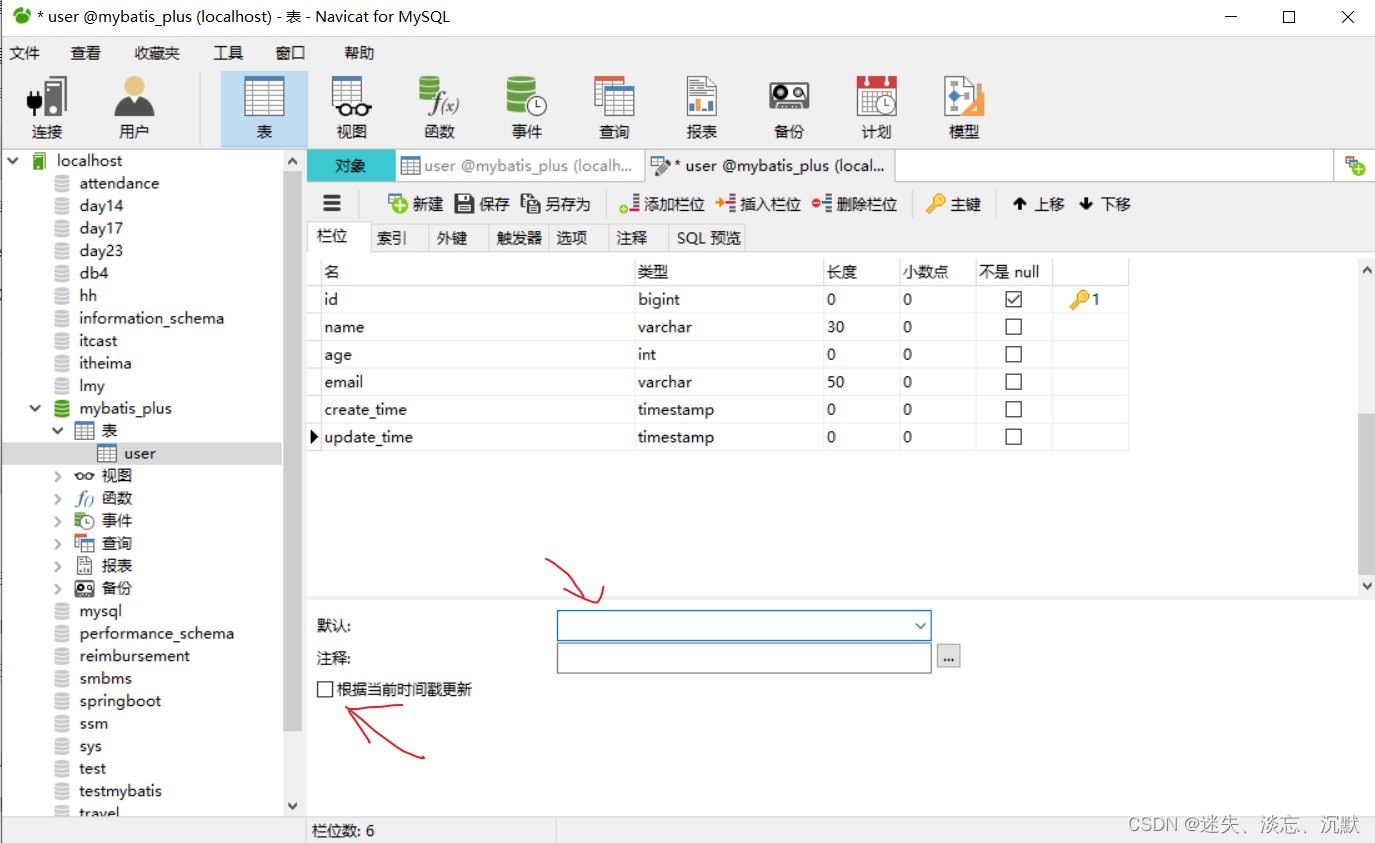
首先我们要将前面数据库级别中的默认设置为null或者不写,还有去掉根据当前时间更新这个框
2.在实体类的字段属性增加注解
部分代码:
packagecom.kuang.pojo;importcom.baomidou.mybatisplus.annotation.FieldFill;importcom.baomidou.mybatisplus.annotation.IdType;importcom.baomidou.mybatisplus.annotation.TableField;importcom.baomidou.mybatisplus.annotation.TableId;importlombok.AllArgsConstructor;importlombok.Data;importlombok.NoArgsConstructor;importjava.time.LocalDateTime;importjava.util.Date;@Data@AllArgsConstructor@NoArgsConstructorpublicclassUser{//对应数据库中的主键(uuid、自增id、雪花算法、redis、zookeeper)@TableId(type =IdType.AUTO)//如果属性值为type = IdType.INPUT ,那么我一旦手动输入id之后,就需要自己配置id了privateLong id;privateString name;privateInteger age;privateString email;//字段添加填充内容@TableField(fill =FieldFill.INSERT)privateLocalDateTime createTime;@TableField(fill =FieldFill.INSERT_UPDATE)privateLocalDateTime updateTime;}
这里一定不要忘记在我们的类上加入@Component,这个是为了将我们的处理器加到IOC容器中,接着我们实现该接口的两个方法,一个插入的填充策略,一个是更新的填充策略,而且使用@Slf4j ,开启log4j日志功能
3.编写处理器来处理注解
packagecom.kuang.handle;importcom.baomidou.mybatisplus.core.handlers.MetaObjectHandler;importlombok.extern.slf4j.Slf4j;importorg.apache.ibatis.reflection.MetaObject;importorg.springframework.stereotype.Component;importjava.time.LocalDateTime;importjava.util.Date;@Slf4j@Component//一定不要忘记将处理器加到IOC容器中!publicclassMyMetaObjectHanderimplementsMetaObjectHandler{//插入时的填充策略@OverridepublicvoidinsertFill(MetaObject metaObject){
log.info("start insert fill.....");//setFieldValByName(String fieldName, Object fieldVal, MetaObject metaObject)//第一个参数 字段名//第二个参数 值//第三个参数 metaObject// this.setFieldValByName("createTime",new Date(),metaObject);// this.setFieldValByName("updateTime",new Date(),metaObject);// 上面的方法是旧版本,新版本的是使用下面的strictInsertFill方法this.strictInsertFill(metaObject,"createTime",LocalDateTime.class,LocalDateTime.now());this.strictUpdateFill(metaObject,"updateTime",LocalDateTime.class,LocalDateTime.now());}//更新时的填充策略@OverridepublicvoidupdateFill(MetaObject metaObject){
log.info("start update fill.....");this.strictUpdateFill(metaObject,"updateTime",LocalDateTime.class,LocalDateTime.now());}}
这里是我从mybatisplus的官方文档改的,不过有一点要注意的是我们要将实体类User里面的属性的类型要改为LocalDateTime这个类型!
4.测试插入和更新
packagecom.kuang;importcom.kuang.mapper.UserMapper;importcom.kuang.pojo.User;importorg.junit.jupiter.api.Test;importorg.junit.runner.RunWith;importorg.springframework.beans.factory.annotation.Autowired;importorg.springframework.boot.test.context.SpringBootTest;importorg.springframework.test.context.junit4.SpringRunner;importjavax.annotation.Resource;importjava.util.List;@SpringBootTestclassMybatisPlusApplicationTests{//继承了BaseMapper,所有的方法都来自父类,我们也可以编写自己的扩展方法@AutowiredprivateUserMapper userMapper;@TestvoidcontextLoads(){// 这里我们的selectList内部的参数是一个Wrapper,条件构造器,这里我们先不用 null//查询全部用户List<User> users = userMapper.selectList(null);
users.forEach(System.out::println);}//测试插入@TestpublicvoidtestInsert(){User user =newUser();// user.setId(6L);
user.setName("万俊锋");
user.setAge(5);
user.setEmail("[email protected]");int result = userMapper.insert(user);//帮我们自动生成System.out.println(result);//受影响的行数System.out.println(user);//发现,id会自动回填}//测试更新@TestpublicvoidtestUpdate(){User user =newUser();//通过条件自动拼接动态SQL
user.setId(6L);
user.setName("关注公众号:代码说");
user.setAge(22);//注意:updateById 但是参数是一个对象!int i = userMapper.updateById(user);System.out.println(i);}}
以上就是Mybatis-plus的自动填充功能,希望能帮助到大家更好的学习mybatis-plus
版权归原作者 迷失、淡忘、沉默 所有, 如有侵权,请联系我们删除。